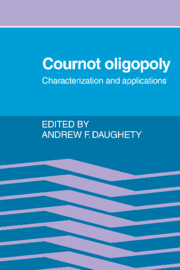Part III - Examining Cournot's model
Published online by Cambridge University Press: 07 September 2009
Summary
Overview
The eight papers in this part deal with various aspects of Cournot's model and analysis and thus focus on the model itself, as opposed to applications of the model. The first three papers explore the basic notion of noncooperative behavior embodied in Cournot's model and focus around two themes: existence and versatility. Novshek's paper provides existence. As discussed in the Introduction, this paper is especially appealing in that it specifically admits cost functions which are conceptually consistent with long-run oligopoly behavior, in stark contrast with the earlier existence literature which usually employed an assumption (such as convexity of all cost functions) that eliminated or severely restricted scale economies.
The versatility of the noncooperative model of multiagent behavior is best seen by considering collusion. At least since Adam Smith many economists have harbored the deep suspicion that, given the opportunity, firms in an industry will collude. The problem for the firms, of course, is how to make the collusion stick. For many years collusion was viewed as requiring individually irrational behavior on the part of the participants: short of enforcement via government intervention, individual maximizing behavior on the part of the agents should lead to defections from the collusive solution. Specifically, at least one firm would find it advantageous to expand output and cut price.
More generally, the strategies for firms that would support a collusive outcome do not form a Nash equilibrium in the one-shot game, since they do not reflect individual maximizing behavior.
- Type
- Chapter
- Information
- Cournot OligopolyCharacterization and Applications, pp. 95 - 100Publisher: Cambridge University PressPrint publication year: 1989



